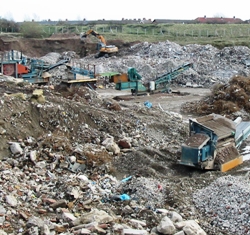
Add carbonate derived (ultimately from plants growing above this material or from associated microbial activity within the soil) and calcite precipitates. To estimate the ultimate potential for carbon capture by these materials requires knowledge of the amount of reactive calcium that is present, and currently there are no standard tests for doing this. The most optimistic estimate would be based on X-ray fluorescence (XRF) analysis of a sample; typically, fines from the demolition of a concrete building can contain up to 20% CaO
2. Thus every tonne of fines from a concrete crusher has the potential to sequester 180kg of CO2 as a consequence of the carbonate-forming reaction, in which 1 mole (56g) of CaO reacts with 1 mole (44g) CO
2 to give 1 mole (100g) CaCO
3, according to the simple equation CaO + CO
2 = CaCO
3.
So, what difference will this approach make? When all is said and done, the use of fines in artificially prepared soils provides no more than a way of compensating for the CO
2 released into the atmosphere by the manufacture of cement in the first place by the decarbonation of limestone. But, for a full Life Cycle Analysis, the burial of fines from concrete crushing helps close the loop (ashes to ashes, dust to dust and all that), meaning that cement, once made, is either reused as a component of secondary aggregates, or goes back into a soil where it recarbonates.
In the UK, cement manufacturing contributes 6 MT/year of CO
2 to the atmosphere. Compensating for this would require 40 million tonnes of demolition waste running at a ‘grade’ of 20% CaO. Coincidentally, the UK also generates 40 million tonnes of demolition waste each year - though only a proportion of this (less than 30%) will end up in soils, giving a CO
2 sequestration potential of about 2MT CO
2 per year.
So - fines from crushed concrete have a role to play in reducing atmospheric CO
2, and as these often ‘end up’ in made ground, this Cinderella of the geological world suddenly appears to don glass slippers. Does made ground have an inherent carbon-capture value? If so, how can we assess and exploit that value?
Obviously, the design of major redevelopment sites could include an assessment of the carbon capture value of retaining on site the crusher fines from aggregate recycling. If we suppose that a hectare of made ground on a site previously occupied by concrete buildings has a one-metre layer of soil dominated by crusher fines, covered by top soil, we are looking at of the order of 20,000 tonnes of demolition ‘waste’ that has the capacity to absorb a total of 3600 tonnes of CO
2 - on top of carbon sequestered as plant tissue. On this basis, a 2.5km
2 site (such as the London Olympics, for example) could absorb almost a million tonnes (0.9 MT) of CO
2 as calcium carbonate. This surely adds to the value of such a development.
Beyond limestone
We also need to look at the scope for designing soils based on blends of quarry fines (especially basalt and dolerite) with composts, and to evaluate the potential of blast furnace slags within soils as carbon capture mechanisms. Although less CaO-rich than cement, basaltic rocks typically contain 9% CaO, and an estimated nine million tonnes per year are produced as crusher fines – with the potential to capture about half a million tonnes per year of CO
2.
About 4MT per year of basic slags are produced in the UK, containing over 45% CaO. If all of this material were available for carbonation, it could sequester 1.5 MT CO
2 every year. More realistically, fines from crushing slag will constitute no more than a third of crusher feed; and so if limited to these materials, the CO
2 sequestration potential is reduced to no more than 0.5 MT CO
2 per year. The total CO
2 sequestration potential in the UK for soils developed from fines arising from demolition, silicate rock quarrying and steel manufacture, comes out at about 3 MT CO
2 per year.
The artificial use of soils that have the capacity to remove atmospheric CO
2 will not solve the world’s greenhouse emission problems at a stroke. But every little helps. The UK’s Renewables Obligation target, which increases annually, is currently 16 MT CO
2 per year, to be met by finding alternatives to fossil fuels. If that is worth chasing, then it is certainly worth maximising the use of soils as a comparatively inexpensive way of sequestering CO
2.
Acknowledgements
This work is funded by the Engineering and Physical Sciences Research Council, award reference EP/F02777X/1.